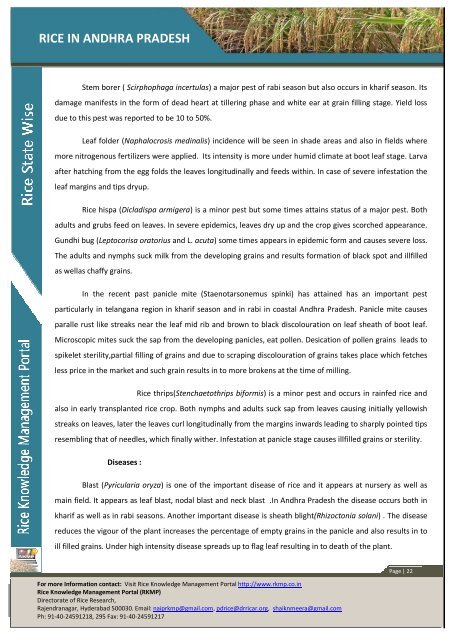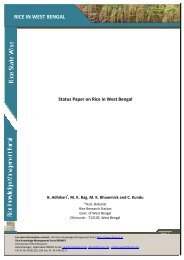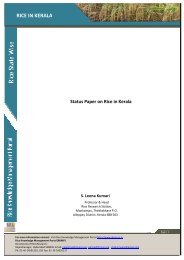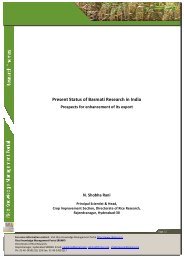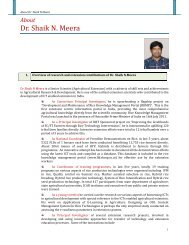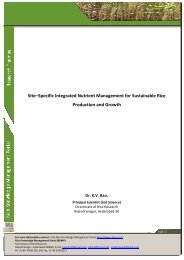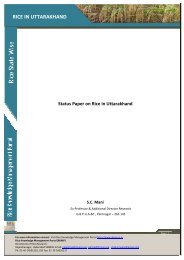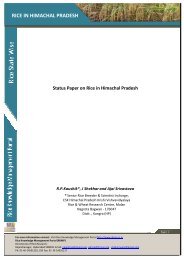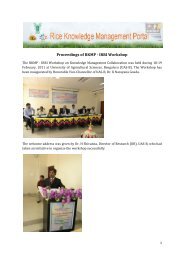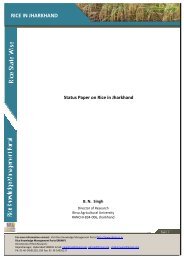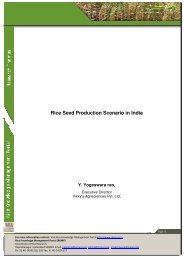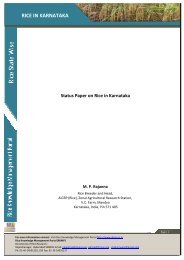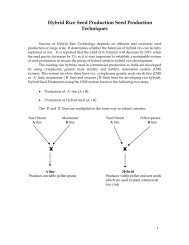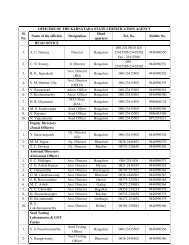RICE IN ANDHRA PRADESH - Rice Knowledge Management Portal
RICE IN ANDHRA PRADESH - Rice Knowledge Management Portal
RICE IN ANDHRA PRADESH - Rice Knowledge Management Portal
You also want an ePaper? Increase the reach of your titles
YUMPU automatically turns print PDFs into web optimized ePapers that Google loves.
<strong>RICE</strong> <strong>IN</strong> <strong>ANDHRA</strong> <strong>PRADESH</strong><br />
Stem borer ( Scirphophaga incertulas) a major pest of rabi season but also occurs in kharif season. Its<br />
damage manifests in the form of dead heart at tillering phase and white ear at grain filling stage. Yield loss<br />
due to this pest was reported to be 10 to 50%.<br />
Leaf folder (Naphalocrosis medinalis) incidence will be seen in shade areas and also in fields where<br />
more nitrogenous fertilizers were applied. Its intensity is more under humid climate at boot leaf stage. Larva<br />
after hatching from the egg folds the leaves longitudinally and feeds within. In case of severe infestation the<br />
leaf margins and tips dryup.<br />
<strong>Rice</strong> hispa (Dicladispa armigera) is a minor pest but some times attains status of a major pest. Both<br />
adults and grubs feed on leaves. In severe epidemics, leaves dry up and the crop gives scorched appearance.<br />
Gundhi bug (Leptocorisa oratorius and L. acuta) some times appears in epidemic form and causes severe loss.<br />
The adults and nymphs suck milk from the developing grains and results formation of black spot and illfilled<br />
as wellas chaffy grains.<br />
In the recent past panicle mite (Staenotarsonemus spinki) has attained has an important pest<br />
particularly in telangana region in kharif season and in rabi in coastal Andhra Pradesh. Panicle mite causes<br />
paralle rust like streaks near the leaf mid rib and brown to black discolouration on leaf sheath of boot leaf.<br />
Microscopic mites suck the sap from the developing panicles, eat pollen. Desication of pollen grains leads to<br />
spikelet sterility,partial filling of grains and due to scraping discolouration of grains takes place which fetches<br />
less price in the market and such grain results in to more brokens at the time of milling.<br />
<strong>Rice</strong> thrips(Stenchaetothrips biformis) is a minor pest and occurs in rainfed rice and<br />
also in early transplanted rice crop. Both nymphs and adults suck sap from leaves causing initially yellowish<br />
streaks on leaves, later the leaves curl longitudinally from the margins inwards leading to sharply pointed tips<br />
resembling that of needles, which finally wither. Infestation at panicle stage causes illfilled grains or sterility.<br />
Diseases :<br />
Blast (Pyricularia oryza) is one of the important disease of rice and it appears at nursery as well as<br />
main field. It appears as leaf blast, nodal blast and neck blast .In Andhra Pradesh the disease occurs both in<br />
kharif as well as in rabi seasons. Another important disease is sheath blight(Rhizoctonia solani) . The disease<br />
reduces the vigour of the plant increases the percentage of empty grains in the panicle and also results in to<br />
ill filled grains. Under high intensity disease spreads up to flag leaf resulting in to death of the plant.<br />
For more Information contact: Visit <strong>Rice</strong> <strong>Knowledge</strong> <strong>Management</strong> <strong>Portal</strong> http://www.rkmp.co.in<br />
<strong>Rice</strong> <strong>Knowledge</strong> <strong>Management</strong> <strong>Portal</strong> (RKMP)<br />
Directorate of <strong>Rice</strong> Research,<br />
Rajendranagar, Hyderabad 500030. Email: naiprkmp@gmail.com, pdrice@drricar.org, shaiknmeera@gmail.com<br />
Ph: 91-40-24591218, 295 Fax: 91-40-24591217<br />
Page | 22


